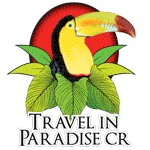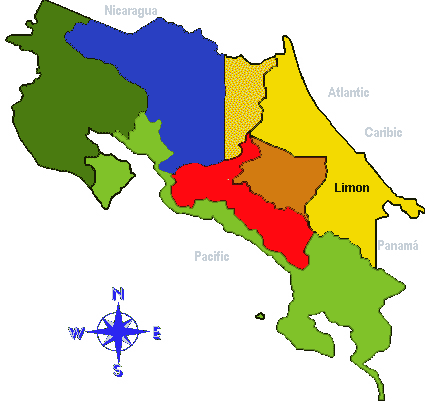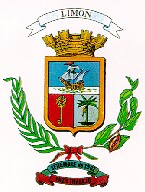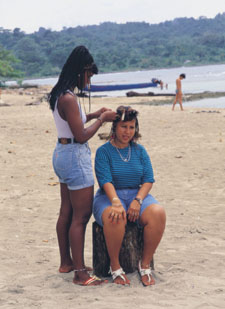#1 Costa Rica Travel in Paradise, Costa Rica Vacations |
|
|
||||||||||||||||
|
Home| Escorted Trip | Family Trip | Honeymoon |Tailor MadeTours | Rent a Car | Hotel | One Day Tours| About C R| Testimonial | FAQ | Contact Us | About Us | Terms| How to Book
|
||||||||||||||||
General Information: Climate: Limón conjures up images of Costa Rica's coconut-fringed Caribbean coast. Although the province does indeed extend the length of this coast -- from the mouth of the San Juan River in the north, to the mouth of the Sixaola River on the Panamanian border -- the southern sector includes a large area of mountainous terrain that stretches up to the country's highest peak, Mt. Chirripó, in the Talamanca Cordillera. Likewise, the provincial boundaries also climb to over 2,000 m. elevation on the northeastern flank of Turrialba Volcano. Despite the rise in elevation from sea level to 3,820 meters, Limón is the only one of Costa Rica's seven provinces to be entirely on the Caribbean side of the Continental Divide, and thus its weather is directly affected by the flow of warm, moist air brought in off this body of water by the northeast trade winds. The result is a climate with no pronounced dry season, even though it does tend to be less rainy in the months of March, April, September, and October, and typically rains the most in June, July, August, November, and December. The lowland regions remain warm and humid year-round, while the higher portions are both cooler and wetter. History: Christopher Columbus, or Cristobal Colón as he is known in Spanish, and his crew were the first Europeans to lay eyes on the shores and forest-covered mountains of Costa Rica. On the great Admiral's fourth and final voyage to the Americas, in 1502, he anchored near what is now the port city and provincial capital of Limón. His brief dealings with the native people he met on the mainland were apparently good-natured, yet this benevolent interaction was not to be the norm during the centuries to come. Spanish settlement of Costa Rica came not from the Atlantic but from the Pacific side of the country. Given the mountainous barrier between the Central Valley and the Caribbean lowlands, as well as the dense forests and high rainfall characteristic of the latter region, would-be colonists were faced with a real challenge. The periodic expeditions organized with, at least in part, the purpose of establishing permanent settlements in the Caribbean region inevitably met with failure. Their cruel treatment of the indigenous people did not help the Spaniards in their objective either, since the natives in the area wholeheartedly resisted colonization. Thus, throughout the three centuries of the colonial period, while the Central Valley and northern Pacific portions of Costa Rica were being progressively dominated by settlers from Spain, the Atlantic wilderness continued to be an untamed frontier. The one small exception was the Valley of Matina where a number of farms existed for the purpose of growing cacao -- the source of cocoa and chocolate, which are produced from the seeds. Although it was a long and difficult journey from the Central Valley to Matina, near the Caribbean coast, the merchants from Cartago who invested in the cacao farms considered it a worthy enterprise given the otherwise limited opportunities for commercial trade with other colonies. Originally, the farms were worked by native people who had been captured and put into slavery. This system met with problems, including legal ones because the authorities officially forbid such treatment of the native population. The solution was the purchase of African slaves from elsewhere in the region. Each worker was given a certain number of plants to tend, and often, after several years service, was given his freedom. This agricultural activity persisted for about 150 years, but never really contributed significantly to the country's economic progress, and by the time of independence from Spain in 1821 had been all but abandoned. It is interesting to note that owing to the scarcity of coinage in colonial times, cacao beans were sometimes used in lieu of currency, or as a basis for bartering. The real opening of Costa Rica's eastern frontier did not come until the second half of the 19th century. In 1867, the site for a Caribbean port was chosen, and it is said that growing on the spot was an old lemon tree, or limón. To make the port accessible from the interior of the country, the government decided to construct a railroad and contracted the services of the North American entrepreneur, Minor Keith, in exchange for 300,000 hectares of land in the Caribbean lowlands, plus other benefits. Keith established banana plantations on the land and brought in Afro-American workers from Jamaica to tend the plantations and build the railroad, thus changing not only the physical environment -- which for thousands of years had been rain forest -- but also the cultural milieu of the region.
National Parks: 1) Barra del Colorado National Wildlife Refuge 2) Tortuguero National Park 3) Braulio Carrillo National Park 4) Cahuita National Park 5) Gandoca - Manzanillo National Wildlife Refuge 6) La Amistad International Park 7) Hitoy - Cerere Biological Reserve 8) Chirripó National Park
Other Points of Interest: 1) Canals north of Limón: The so-called Canales de Tortuguero are the result of a dredging operation carried out in the 1960's to link a series of naturally occurring lagoons and river courses, thus permitting inland navigation between the city of Limón and the northeastern coastal villages. Prior to the opening of the canal in 1969, transportation of people and products to and from these villages was in dugout vessels that ventured out the river mouths to the open sea and then up or down the coast. The risk inherent in this method of transportation was greatly reduced once the canal system became functional. With the growing numbers of tourists interested in visiting Tortuguero National Park, this route has become increasingly more transited, yet it still retains much of its scenic quality. Shortly after leaving the dock at Moín, you pass through one of the few mangrove areas to be found on the Caribbean side of the country. The red mangroves here are impressive with their prop roots dropping sometimes from five meters or more above the water level and the overall heights of the trees reaching to over 15 meters. Both here and along the length of the waterway system you can observe a variety of birds that live in association with riverine habitats, including herons, egrets, kingfishers, ospreys, jacanas, cormorants, and anhingas. Between the mangrove section and the start of the national park, nearly 50 km. further north, there is not much intact forest left along the canal. However, you can observe the lifestyle of the inhabitants along the way and try to spot sloths and iguanas in any places where there are still trees. 2) KéköLdi Indigenous Reserve: Costa Rica's indigenous population is relatively small and disperse. The Talamanca mountains provided the last refuge for the native people from the relentless advances of western colonization and it is here that the greatest number of reservations have been established. Most of the reserves are still not readily accessible or set up to attend to tourists. However, with prior permission obtained at the ATEC (Talamanca Association for Ecotourism and Conservation) office in Puerto Viejo, a guided visit can be arranged to the KéköLdi Reserve. A morning walk through a portion of this small reserve is an enlightening experience as you learn about native lifestyles, customs, and beliefs. The two indigenous groups, Bribri and Cabecar, that live in the reserve are descendants of people who have lived in this rain forest region for thousands of years and have developed an environmentally sound approach to life in such conditions. Their way of life in harmony with nature provides a sharp contrast to the bulldozer and chainsaw mentality so evident outside the reserve.
Travel Tips:
|
FAQs: You might be wondering too. What to pack: click here to get ideas on what you really need to bring along. What to wear: click here to get ideas on what to wear. Avoid mistaken clothes. Our Specialty Your Best Travel, vacations Family Trips, Honeymoons, Educational Trip, Escorted Trip. Honeymoon Beyond a romantic setting, a honeymoon in Paradise is a magical experience. Family oriented Trip : Is about experiencing fascinating cultures, family adventures, family tours, quality time together. Incentives travels: Creative ideas, consulting services for a theme party or special event.
|
All rights reserved.
All contents Copyright © 2004 -2015 Costa Rica Travel In Paradise Group Tours
|













